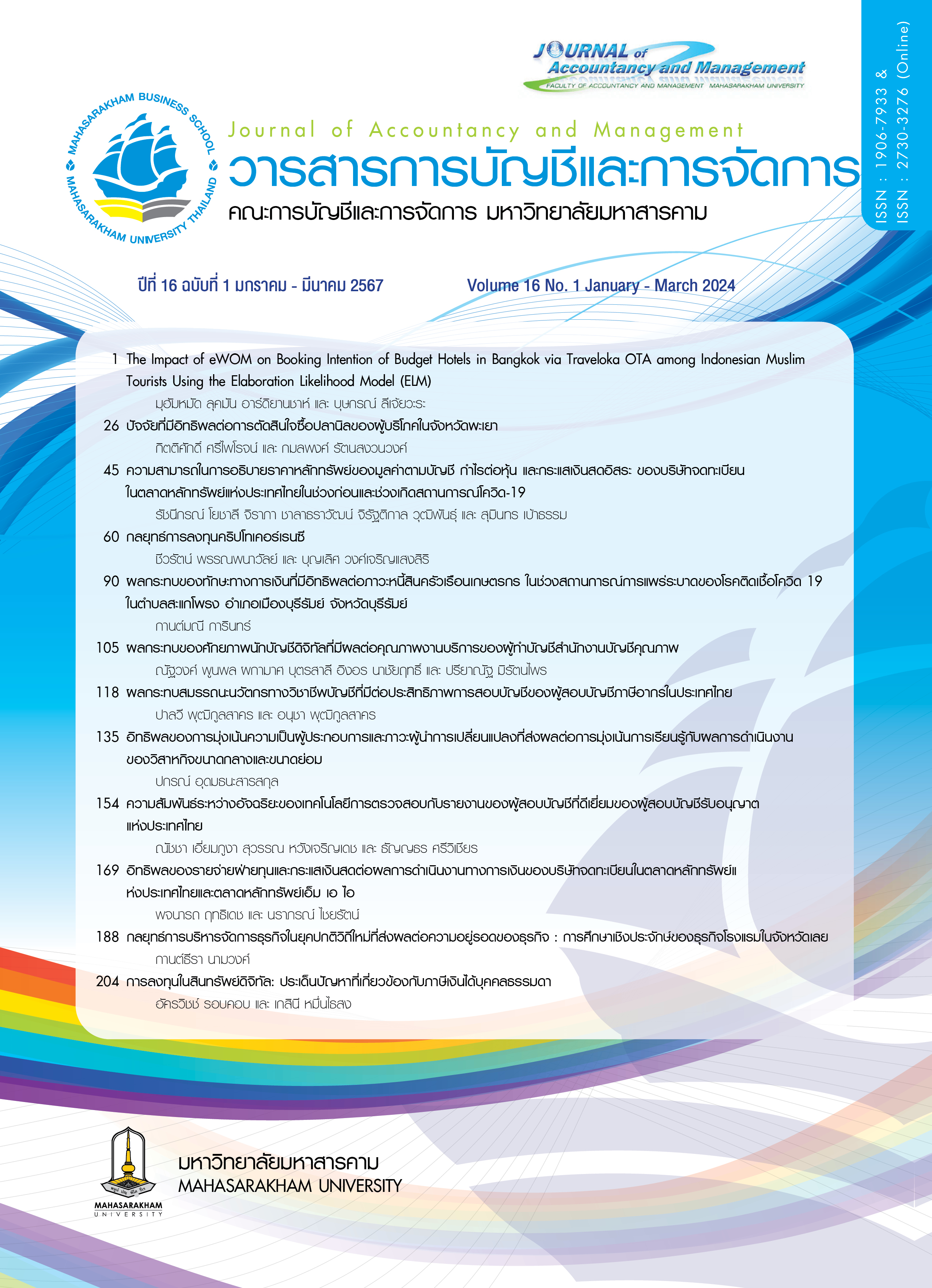อิทธิพลของรายจ่ายฝ่ายทุนและกระแสเงินสดต่อผลการดำเนินงานทางการเงินของบริษัทจดทะเบียนในตลาดหลักทรัพย์แห่งประเทศไทย และตลาดหลักทรัพย์เอ็ม เอ ไอ
Main Article Content
บทคัดย่อ
การศึกษาครั้งนี้มีวัตถุประสงค์เพื่อทดสอบอิทธิพลของรายจ่ายฝ่ายทุนและกระแสเงินสดต่อผลการดำเนินงานทางการเงินของบริษัทที่จดทะเบียนในตลาดหลักทรัพย์แห่งประเทศไทยและตลาดหลักทรัพย์เอ็ม เอ ไอ ประชากรที่ใช้คือ บริษัทที่จดทะเบียนในตลาดหลักทรัพย์แห่งประเทศไทยและตลาดหลักทรัพย์เอ็ม เอ ไอ จัดเก็บข้อมูลระหว่างปี 2558-2564 ใช้วิธีการสุ่มตัวอย่างแบบอย่างง่าย ได้กลุ่มตัวอย่างจำนวน 221 บริษัท โดยจัดเก็บข้อมูลทุติยภูมิจากฐานข้อมูลออนไลน์เว็บไซต์ตลาดหลักทรัพย์แห่งประเทศไทยซึ่งประกอบด้วย งบการเงิน แบบแสดงรายการข้อมูลประจำปี (แบบ 56-1) และรายงานประจำปีของบริษัท ในการศึกษาครั้งนี้ใช้การวิเคราะห์ข้อมูลเชิงพรรณนา การวิเคราะห์สหสัมพันธ์และการวิเคราะห์ความสัมพันธ์เชิงพหุคูณ ผลการศึกษาพบว่ารายจ่ายฝ่ายทุนมีอิทธิพลต่อผลการดำเนินงานทางการเงินในช่วงระยะเวลาการวิเคราะห์ 3 ปี กับ 5 ปี ส่วนช่วงระยะเวลาการวิเคราะห์ 7 ปี ไม่มีอิทธิพลต่อผลการดำเนินงานทางการเงิน กระแสเงินสดจากกิจกรรมลงทุนมีอิทธิพลเชิงลบต่อผลการดำเนินงานทางการเงินทุกช่วงระยะเวลา ซึ่งหมายถึงรายจ่ายลงทุนมากจะส่งผลให้กำไรเพิ่มขึ้น กระแสเงินสดจากกิจกรรมดำเนินงานและขนาดของกิจการมีอิทธิพลต่อผลการดำเนินงานทางการเงินทุกช่วงระยะเวลา กระแสเงินสดจากกิจกรรมจัดหาเงินมีอิทธิพลเชิงลบต่อผลการดำเนินงานทางการเงินในช่วงระยะเวลาการวิเคราะห์ 3 ปี กับ 5 ปี ส่วนช่วงระยะเวลาการวิเคราะห์ 7 ปี มีอิทธิพลเชิงบวก ซึ่งจากผลการศึกษาผู้บริหารสามารถนำข้อมูลไปประกอบการจัดสรรกระแสเงินสดให้เหมาะสมในแต่ละกิจกรรม โดยเฉพาะกิจกรรมลงทุนที่กิจการควรพิจารณาลงทุนเฉพาะที่จำเป็น สำหรับนักลงทุนสามารถนำข้อมูลกระแสเงินสดไปพิจารณาในการลงทุน และสำหรับแหล่งเงินทุนสามารถนำข้อมูลกระแสเงินสดไปประกอบการพิจารณาสนับสนุนเงินทุนสำหรับกิจการได้
Downloads
Article Details

อนุญาตภายใต้เงื่อนไข Creative Commons Attribution-NonCommercial-NoDerivatives 4.0 International License.
บทความที่ได้รับการตีพิมพ์เป็นลิขสิทธิ์ของวารสารการบัญชีและการจัดการ
ข้อความที่ปรากฏในบทความแต่ละเรื่องในวารสารวิชาการเล่มนี้เป็นความคิดเห็นส่วนตัวของผู้เขียนแต่ละท่านไม่เกี่ยวข้องกับมหาวิทยาลัยมหาสารคาม และคณาจารย์ท่านอื่นๆในมหาวิทยาลัยฯ แต่อย่างใด ความรับผิดชอบองค์ประกอบทั้งหมดของบทความแต่ละเรื่องเป็นของผู้เขียนแต่ละท่าน หากมีความผิดพลาดใดๆ ผู้เขียนแต่ละท่านจะรับผิดชอบบทความของตนเองแต่ผู้เดียว
เอกสารอ้างอิง
กรมสรรพากร. (2559ก). พระราชกฤษฎีกาฉบับที่ 598, ค้นเมื่อ วันที่ 24 กุมภาพันธ์ 2566, จาก https://www.rd.go.th/fileadmin/user_upload/kormor/newlaw/598.pdf
กรมสรรพากร. (2559ข). พระราชกฤษฎีกาฉบับที่ 604, ค้นเมื่อ วันที่ 24 กุมภาพันธ์ 2566, จาก https://www.rd.go.th/fileadmin/user_upload/kormor/newlaw/dc604.pdf
จตุรพร กาญจนบุตร. (2557). ความสัมพันธ์ระหว่างกระแสเงินสดสุทธิจากกิจกรรมดำเนินงาน กิจกรรมลงทุน และกิจกรรมจัดหาเงิน กับกำไร (ขาดทุน) สุทธิของธุรกิจสื่อสารไร้สาย. ค้นคว้าอิสระ บัญชีมหาบัณฑิต
บัณฑิตวิทยาลัย มหาวิทยาลัยศรีปทุม.
จักรพันธ์ วงษาเทพ และ นงค์นิตย์ จันทร์จรัส. (2564). โครงสร้างคณะกรรมการบริหารบริษัทและผลการดำเนินงานของบริษัทจดทะเบียนกลุ่มบริการในตลาดหลักทรัพย์แห่งประเทศไทย. Journal of Modern Learning Development, 6(1), 174–184.
ชาญชัย เมธาวิรุฬห์. (2565). บทบาทของนวัตกรรมที่เป็นมิตรกับสิ่งแวดล้อมต่อผลการดำเนินงานสิ่งแวดล้อม และผลการดำเนินงานทางการเงิน ในอุตสาหกรรมผู้ให้บริการโลจิสติกส์. วารสารบริหารธุรกิจนิด้า, 31, 76–95.
ณัฐพัชร์ จูเปีย. (2565). ความสัมพันธ์ระหว่างขนาดของกิจการและความสามารถในการทำกำไร หลักฐานจากบริษัท จดทะเบียนในตลาดหลักทรัพย์แห่งประเทศไทยในกลุ่มอุตสาหกรรมบริการ หมวดธุรกิจพาณิชย์. วิทยานิพนธ์ปริญญามหาบัณฑิต มหาวิทยาลัยกรุงเทพ.
ณิศดาภัทธิ์ ชะโลธร. (2563). ความสัมพันธ์ระหว่างกระแสเงินสดจากผลประกอบการกับผลตอบแทนกำไร (ขาดทุน) ของบริษัทในตลาดหลักทรัพย์แห่งประเทศไทยกลุ่มเทคโนโลยีสารสนเทศและการสื่อสาร ปี พ.ศ. 2553-พ.ศ. 2562. วิทยานิพนธ์ปริญญามหาบัณฑิต มหาวิทยาลัยหอการค้าไทย.
ตลาดหลักทรัพย์แห่งประเทศไทย. (2565). กฎเกณฑ์และการกำกับ-ตลาดหลักทรัพย์แห่งประเทศไทย. ค้นเมื่อ วันที่ 25 กุมภาพันธ์ 2566, จาก https://www.set.or.th/th/rules-regulations/forms
ทิพาพร ยอดดําเนิน. (2562). ความสัมพันธ์ระหว่างกระแสเงินสด ผลตอบแทนของสินทรัพย์และผลตอบแทนของผู้ถือหุ้นของบริษัทจดทะเบียนในตลาดหลักทรัพย์แห่งประเทศไทยในกลุ่ม เอ็ม เอ ไอ กรณีศึกษากลุ่มอุตสาหกรรมสินค้าอุปโภคบริโภค . วิทยานิพนธ์ปริญญามหาบัณฑิต มหาวิทยาลัยศรีปทุม.
ธกานต์ ชาติวงค์. (2560). ทฤษฎีที่ใช้อธิบายงานวิจัยทางบัญชี:จากอดีตถึงอนาคต. วารสารวิชาการบริหารธุรกิจ สมาคมสถาบันอุดมศึกษาเอกชนแห่งประเทศไทย ในพระราชูปถัมภ์ สมเด็จพระเทพรัตนราชสุดาฯ
ยามบรมราชกุมาร, 6(2), 203–212.
ธนาคารแห่งประเทศไทย. (2559). รายงานภาวะเศรษฐกิจไทยปี 2559. ค้นเมื่อ วันที่ 25 กุมภาพันธ์ 2566, จาก https://www.bot.or.th/Thai/MonetaryPolicy/EconomicConditions/AnnualReport/AnnualReport/Annual_Y59_T.pdf
ธีรวุฒิ เอกะกุล. (2543). ระเบียบวิธีวิจัยทางพฤติกรรมศาสตร์และสังคมศาสตร์. อุบลราชธานี : สถาบันราชภัฏอุบลราชธานี.
ประสิทธิชัย ดอกไม้หอม และฐิตาภรณ์ สินจรูญศักดิ์. (2564, 17-18 ,มิถุนายน). ผลกระทบของกระแสเงินสดต่อความสามารถในการทํากําไรและการประเมินมูลค่าหุ้นของ บริษัทจดทะเบียนในตลาดหลักทรัพย์ เอ็ม เอ ไอ. การประชุมสวนสุนันทาวิชาการระดับชาติ ครั้งที่ 9 เรื่อง “การยกระดับงานวิจัยสู่นวัตกรรม” มหาวิทยาลัย
ราชภัฎสวนสุนันทา, กรุงเทพมหานคร.
พรพรรณ เอมอ่อน และนิ่มนวล วิเศษสรรพ์. (2565). อิทธิพลของคุณภาพการกำกับดูแลกิจการต่อความสัมพันธ์ระหว่างสัดส่วนการถือหุ้นสามัญส่วนใหญ่กับมูลค่าตลาดของกิจการ: กรณีบริษัทจดทะเบียน ในตลาดหลักทรัพย์แห่งประเทศไทย. วารสารการบัญชีและการจัดการ มหาวิทยาลัยมหาสารคาม, 14(2), 23-44.
พระนิทัศน์ วงศ์วังเพิ่ม พระวุฒิพงษ์ แก้วแกมดา และปรัชญา มีโนนทองมหาศาล. (2564). การกำหนดประชากรและกลุ่มตัวอย่างในงานวิจัย. วารสารบัณฑิตศึกษา มหาวิทยาลัยราชภัฏสกลนคร, 18(83), 1–9.
เพ็ญนิภา พรหมโคตร และนงค์นิตย์ จันทร์จรัส. (2560). กระแสเงินสด ผลตอบแทนของหลักทรัพย์ และผลการดำเนินงานของบริษัทจดทะเบียนในตลาดหลักทรัพย์ เอ็ม เอ ไอ. วารสารบริหารธุรกิจและการบัญชี มหาวิทยาลัยขอนแก่น, 1(3), 35–50.
ภูมิศักดิ์ สินจรูญศักดิ์ และเบญจพร โมกขะเวส. (2565). ผลกระทบของกระแสเงินสดที่มีต่อกำไรสุทธิและกำไร
ในอนาคตของบริษัทจดทะเบียนในตลาดหลักทรัพย์แห่งประเทศไทย กลุ่มอุตสาหกรรมบริการ. Journal
of Modern Learning Development, 7(10), 29–45.
มยุรา คงสกูล และกนกศักดิ์ สุขวัฒนาสินิทธิ์. (2565). ผลกระทบระหว่างการกำกับดูแลกิจการ กระแสเงินสด
และความสามารถในการทำกำไร ของบริษัทที่จดทะเบียนในตลาดหลักทรัพย์ SET100. วารสารมหาจุฬานาครทรรศน์, 9(7), 273–286.
มินธิตา วรสินธ์พันธ์ และพรทิวา แสงเขียว. (2565). อิทธิพลของอัตราส่วนสภาพคล่องและอัตราส่วนกระแสเงินสดจากกิจกรรมดำเนินงาน ที่มีผลต่ออัตราผลตอบแทนจากการลงทุนในหลักทรัพย์ และกำไรในอนาคตของบริษัทจดทะเบียนในตลาดหลักทรัพย์ แห่งประเทศไทย กลุ่มอุตสาหกรรม อสังหาริมทรัพย์และก่อสร้าง. Journal of Modern Learning Development, 7(10), 148–161.
รองเอก วรรณพฤกษ์. (2559). ผลของสินทรัพย์ไม่มีตัวตนต่อมูลค่ากิจการผ่านผลการดำเนินงานของ บริษัทที่จดทะเบียนในตลาดหลักทรัพย์แห่งประเทศไทย (รายงานการวิจัย). คณะบัญชี มหาวิทยาลัยศรีปทุม.
สภาวิชาชีพบัญชีในพระบรมราชูปถัมภ์. (2561). มาตรฐานการบัญชีฉบับที่ 7 (ปรับปรุง 2561) เรื่องงบกระแสเงินสด. ค้นเมื่อ 3 มีนาคม 2566, จาก https://www.tfac.or.th/upload/9414/TSeoIr9x6i.PDF
Connelly, B. L., Certo, S. T., Ireland, R. D., & Reutzel, C. R. (2011). Signaling Theory: A Review and Assessment. Journal of Management, 37(1), 39–67.
Cordis, A. S., & Kirby, C. (2017). Capital expenditures and firm performance: Evidence from a cross-sectional analysis of stock returns. Accounting & Finance, 57(4), 1019–1042.
Dogan, M. (2013). Does Firm Size Affect The Firm Profitability? Evidence from Turkey. Research Journal of Finance and Accounting, 4(4), 53-59.
Dovita, Y. G., Rokhmawati, A., & Fathoni, A. F. (2019). The Effect of Sales Growth, Capital Expenditure, and Working Capital Efficiency on Indonesian-Listed-Consumer-Goods Firms’ Financial Performance with Capital Structure as Moderating Variable. Indonesian Journal of Economics, Social, and Humanities, 1(1), 1–15.
Field, A. (2009). Discovering Statistics Using SPSS. London : Sage Publications Ltd.
Franke, G. R. (2010). Multicollinearity. In Wiley International Encyclopedia of Marketing. New Jersey : John Wiley & Sons, Ltd.
Ikechukwu, O. I., Nwakaego, D. A., & Celestine, A. I. (2016). The Effect of Cash Flow Statement on Companies Profitability (A Study of Some Selected Banks in Nigeria). African Journal of Basic & Applied Sciences. 7(6), 350-356.
Jaisinghani, D., Tandon, D., & Batra, D. K. (2018). Capital expenditure and persistence of firm performance: An empirical study for the Indian automobiles industry. International Journal of Indian Culture and Business Management, 16(1), 39–56.
Jiang, C., Chen, H., & Huang, Y. (2006). Capital expenditures and corporate earnings: Evidence from the Taiwan Stock Exchange. Managerial Finance, 32(11), 853–861.
Kim, S., Saha, A., & Bose, S. (2021). Do capital expenditures influence earnings performance: Evidence from loss-making firms. Accounting & Finance, 61(S1), 2539–2575.
Maulana, R. (2021). Pengaruh capital expenditure, profitabilitas, leverage, dan corporate social responsibility disclosure terhadap kinerja keuangan. University of Islam Malang.
Momanyi, K. W. (2017). Effect of cash flows on financial performance of firms listed in the Nairobi securities exchange. International Journal of Social Sciences and Information Technology, 2(11), 1400-1415.
Mwangi, R. W. (2014). The effect of capital expenditure on financial performance of firms listed at the Nairobi securities exchange [Thesis]. http://erepository.uonbi.ac.ke/handle/11295/75458
Nguyen, N. (2015). Does Hedging Increase Firm Value. An Examination of Companies. Master Thesis, Lund University).
Noviyanti, N., Ismawati, I., & Rosiana, R. (2022). The Effect of Capital Expenditure and Corporate Hedging on Firm Value with Exchange Rate as Moderating Variable: Firm Value. Journal of Applied Business, Taxation and Economics Research, 2(1), 1–8.
Ones, U. (2019). Effects of R&D and Capital Expenditure on Firm Performance: Evidence from Technology Hardware and Equipment Sector. Ankara Universitesi SBF Dergisi, 74 (4), 1401-1421.
Rahmiati, R., & Sari, W. (2013). Pengaruh Capital Expenditure, Struktur Modal dan Profitabilitas terhadap Nilai Perusahaan (Studi pada Perusahaan Manufaktur yang Terdaftar di Bursa Efek Indonesia). Jurnal Kajian Manajemen Bisnis, 2(1), 1-14.
Spence, M. (1973). Job market signaling. The quarterly journal of Economics, 87(3), 355-374.
Taipi, E., & Ballkoci, V. (2017). Capital Expenditure and Firm Performance Evidence from Albanian Construction Sector. European Scientific Journal, ESJ, 13(28), 231-238.
Ullah, S., Irfan, M., Kim, J. R., & Ullah, F. (2021). Capital expenditures, corporate hedging and firm value. The Quarterly Review of Economics and Finance, 87(1), 1-24.
Uwah, U. E. (2019). Capital Expenditure Decisions and Long term Value of the Firm: Evidence from Nigerian Manufacturing Companies. 8(1), 152–169.


